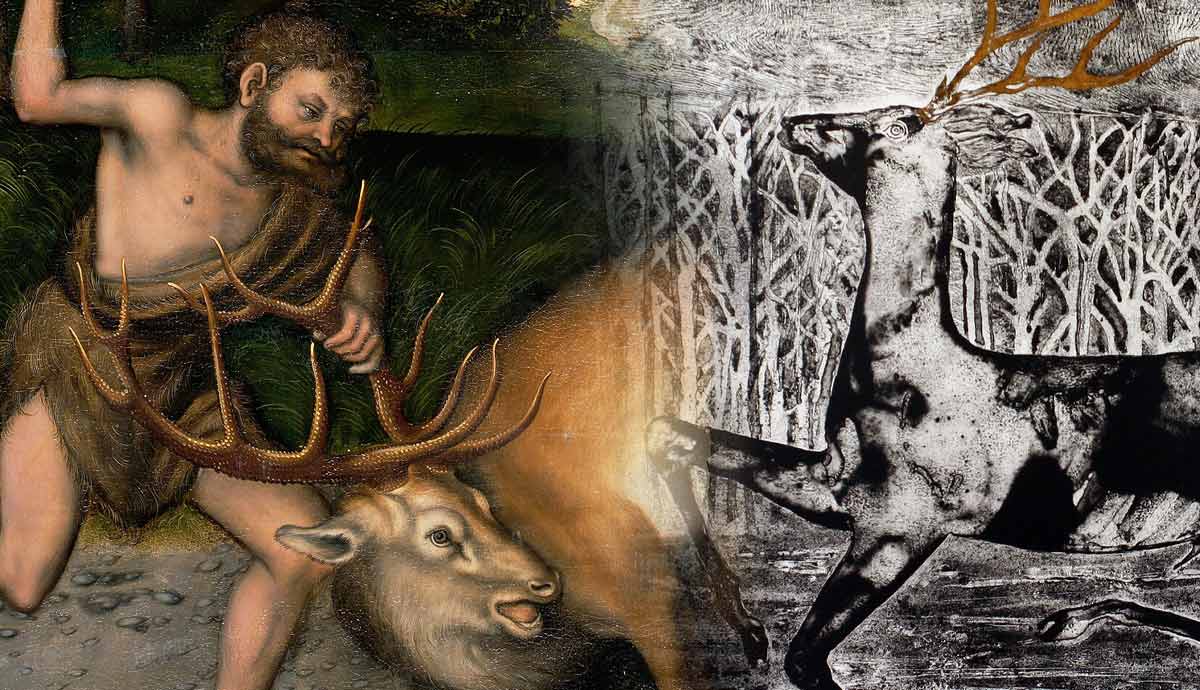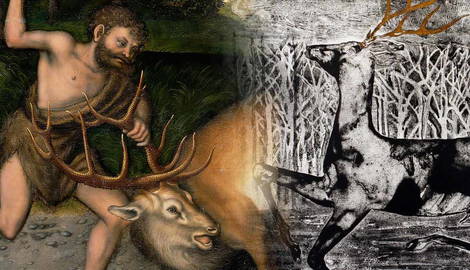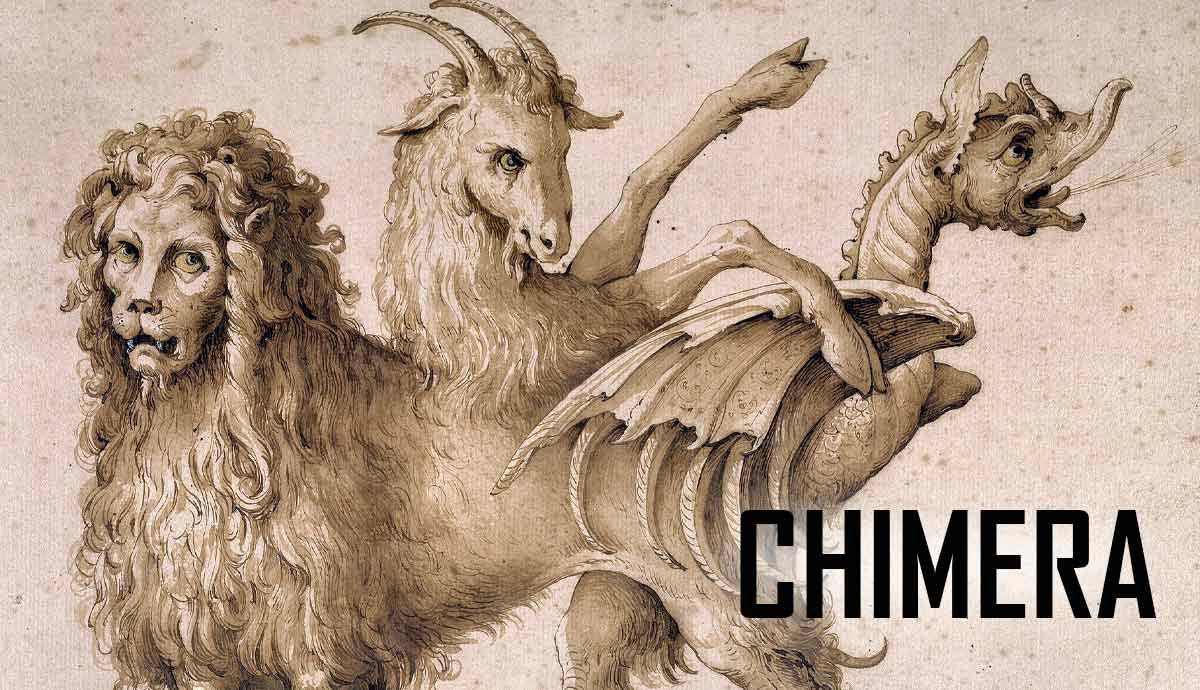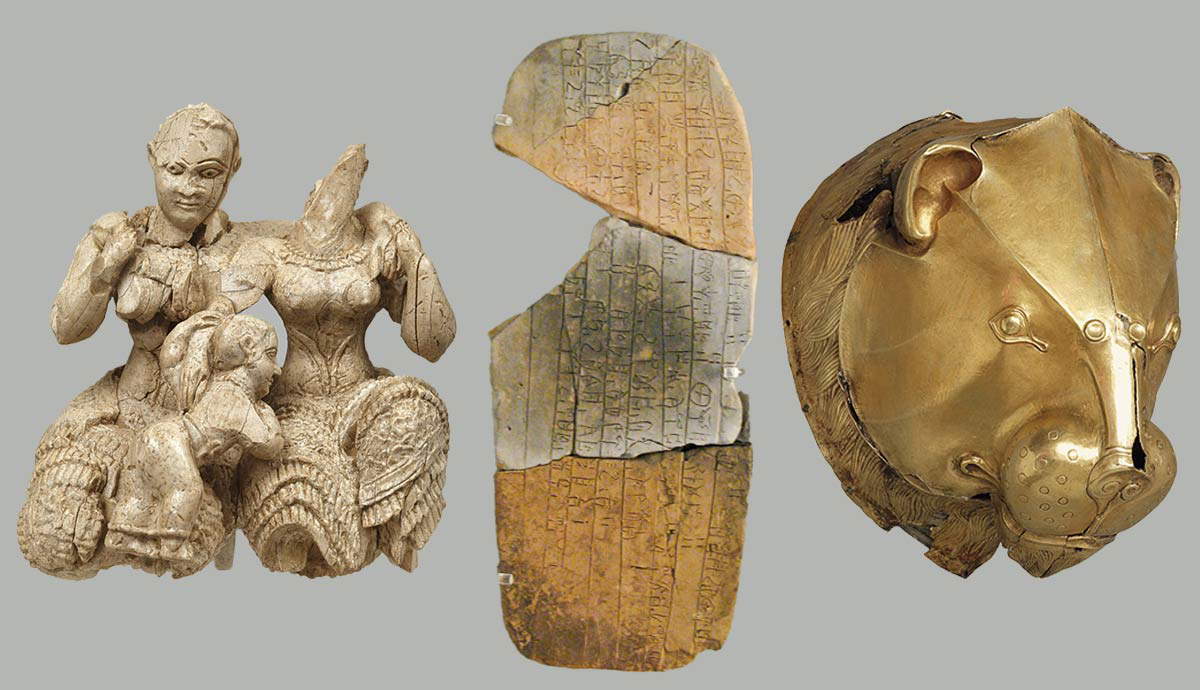
After completing his second labor, slaying the immortal Hydra, King Eurystheus commanded Heracles to capture the Ceryneian Hind. The Ceryneian Hind was a mythical female deer with golden horns and bronze hooves. It was as big as a bull and incredibly fast, capable of outrunning arrows. However, the real challenge was not the deer’s speed but that she was sacred to the goddess Artemis. Any attempt to harm or hinder the deer would incur Artemis’ divine wrath. Read on to learn how Heracles caught the deer without evoking Artemis’ anger.
The Ceryneian Hind: A Different Kind of Challenge

Upon returning to Tiryns after defeating the Lernaean Hydra, Heracles was accused of cheating by King Eurystheus for allowing Iolus to help him. Eurystheus planned to punish Heracles with an additional eleventh task. Despite the fuss Eurystheus made over how Heracles defeated the immortal Hydra, it did not change the fact that the monster was still dead. When Heracles had left with Iolaus for his second labor, the king was confident that he would never return. However, defying Hera’s will, Heracles did return.
Much to the dismay of Hera and Eurystheus, Heracles proved to be highly gifted in defeating monsters that were thought to be unbeatable. The Nemean Lion and the Lernean Hydra were considered invincible creatures, but Heracles managed to find their weaknesses and destroy them. Therefore, a new and different challenge was required to make him fail. It needed to be something that could not be overcome by brute force, something which would require a more nuanced approach.
Through Hera’s divine whispers, Eurystheus assigned Heracles a task unlike any he had faced before, and that would, without a doubt, lead to his demise. Standing outside the gates of Tiryns, King Eurystheus revealed the third labor: to capture and deliver to him the Ceryneian Hind.
The Ceryneian Hind: Not an Ordinary Deer

The Ceryneian Hind was a different sort of challenge for Heracles than his previous two labors. The Nemean Lion and Lernean Hydra were monsters that caused havoc and death among the locals and needed to be defeated. The Ceryneian Hind was generally a non-aggressive creature that did not cause destruction or harass the local population. Instead, it was a peaceful animal that spent its days frolicking in the wilderness near Ceryneia, a town located in the region of Achaea in the northern Peloponnese.
Despite its relatively peaceful nature, capturing the Ceryneian Hind posed a significant challenge to Heracles. This was no ordinary deer. She was as large as a bull and had golden horns, bronze hooves, and a dappled hide. Most accounts of the Ceryneian Hind describe her as a gentle and peaceful creature. However, some versions of the story portray the Ceryneian Hind as a more hostile animal that breathed fire, attacked nearby vineyards, and threatened local farmers.
The Ceryneian Hind was said to be one of the swiftest animals in the world, easily outrunning an arrow. Her speed was only part of the challenge. The main issue was that the Ceryneian Hind was sacred to the goddess Artemis, and any attempt to harm the deer would bring down the goddess’s divine wrath upon the culprit.
The Ceryneian Hind: The Golden Deer of Artemis

Ceryneian Hind was likely an ordinary deer before becoming entangled in the lives of the immortals, who transformed it forever. Her story begins, as is often the case with Greek myths, with the lust of Zeus. According to the legend, Taygete, a Pleiad nymph, caught the eye of the King of gods. The Pleiads were seven sisters who were renowned for their striking beauty. They were the daughters of the Titan Atlas and the Oceanid Pleione. Over time, various male Olympians such as Zeus, Poseidon, and Ares courted or pursued the Pleiads.
Taygete was a devoted follower of Artemis and often accompanied the goddess on her hunting expeditions. Like her patron, Taygete had taken a vow of chastity and refused Zeus’ advances. However, Zeus persisted and began to chase her across the Peloponnese. Taygete knew she could not outrun the King of Olympus and prayed to Artemis for help. Artemis heard her followers call for help and transformed Taygete into a deer or cow, hiding her from Zeus. The disguise worked and Zeus stopped pursuing Taygete for the time being.
In gratitude for Artemis’ assistance, Taygete presented her with a herd of five exquisite and swift-footed female deer. According to some versions of the myth, after Taygete dedicated the herd to Artemis, she transformed their horns into gold and hooves into bronze.
Artemis was so taken by the magnificent animals that she began using four of them to pull her sacred golden chariot while leaving one deer alone in the Olympian stables. This remaining deer escaped, either on its own or with Hera’s help, who planned to use it against Heracles. The Ceryneian Hind was allowed to return home to the northern Peloponnese under the divine protection of Artemis. The goddess chose not to capture her sacred animal, preferring the Golden Hind to be free in the wilderness.
The Hunt for the Hind: The Gentle Approach

Heracles accepted his new task without complaint but knew it would be more challenging than his previous labors. The Ceryneian Hind was sacred to his half-sister Artemis, notorious for her violent retribution towards those who wronged her. Heracles recognized that capturing the Hind would require a delicate touch, which was not one of his strong suits.
Heracles was a brave and strong character, unafraid of going into battle and bashing his enemies using his club. However, this time, his brute strength would be of little help to him. Instead, he had to employ his speed, intelligence, and patience to capture the creature without causing it any harm. Heracles knew that even a small injury to the Hind could have dire consequences. If he caused any damage to the animal, Artemis might instantly kill him or, worse, transform him into an animal and hunt him down.

Heracles had no trouble tracking down the Ceryneian Hind in the dense forests around Ceryneia. Despite its reputation for incredible speed, its glittering golden horns and bronze hooves made it easy to spot for any hunter foolish enough to pursue it.
When Heracles tried to capture the Ceryneian Hind, he faced a dilemma. He could not risk injuring the creature by attacking it from afar with his bow, and even using a net failed due to the Hind’s incredible speed. Heracles attempted to approach the Golden Hind quietly, but as he drew near, the creature quickly fled beyond his reach. This left Heracles with only one option: to chase the Ceryneian Hind until it was exhausted and could no longer run, then capture it. This new strategy led to an elaborate chase lasting over a year.
The Hunt for the Hind: The Great Chase

Heracles chased the Ceryneian Hind across Greece, swiftly moving away from the Peloponnese and heading northward, passing Athens and his hometown of Thebes. Whenever Heracles caught a glimpse of the Hind’s gleaming horns, it darted away before he could get close. Heracles pursued the Hind to Hyperborea, a fabled land far north of Greece, beyond the Danube River. Hyperborea was considered a mythical paradise, where the Hyperboreans solely worshipped Apollo and it was home to Griffins, who guarded mountains of gold.
After reaching the far north, Heracles chased the Ceryneian Hind back to Greece. The pursuit continued until they reached the foothills of Mount Artemisium in the Peloponnese, just a short distance from where the hunt had started. At first, the Hind was just a distant golden glimmer on the horizon. But after a relentless year-long pursuit, she was significantly fatigued while Heracles never tired due to his supernatural stamina. Heracles’ patience had paid off.
The Ceryneian Hind was now exhausted and struggling to stay ahead of Heracles. At last, the elusive creature was within his grasp. Heracles’ moment came as they reached the banks of the River Ladon.

As the Ceryneian Hind crossed the river, it slowed down. Heracles saw this as an opportunity and took out his bow. Instead of aiming at the Hind, Heracles fired an arrow into the ground just ahead of her. The arrow hit its target, causing the Hind to trip and lose its balance near the riverbank. Heracles quickly took advantage of the situation, leaped forward, seized the golden horns of the Hind, and wrestled her to the ground.
In some versions, Heracles captures the Hind using a net or tackles it as it approaches the river instead of using a bow. Heracles shoots and fatally injures the Ceryneian Hind in versions of the myth in which she is portrayed as a hostile, fire-breathing beast that terrorizes local farmers.
Wrath of Artemis: Helpless Heracles

After successfully wrestling the Ceryneian Hind into submission, Heracles carefully bound it and slung her over his shoulders. He then began his journey back to Tiryns to present his quarry to Eurystheus. Heracles knew that the capture of the Ceryneian Hind was just the start of his labor. As he walked, he waited for Artemis’ response to his blasphemy, knowing that the goddess would not be pleased with his actions.
Sure enough, Artemis appeared before Heracles less than an hour after capturing the Hind. Artemis’ expression was one of simmering rage. Heracles, despite his strength and courage, was taken aback by the anger in her eyes. He stepped back, bumping unexpectedly into Apollo. Heracles found himself in a precarious situation, wedged between the twin deities of the sun and the moon. The divine twins gave Heracles disdainful glares as he carried off one of their sacred pets.

Heracles is remembered as a courageous hero who overcame every obstacle with overwhelming strength. Even with his supernatural strength, Heracles knew he was no match for one Olympian, let alone two. All Heracles had left was his bravery and wit, and so the hero did something out of character: he surrendered.
Heracles knelt and bowed before the goddess of the hunt, showing his humility. As a punishment for his disrespect and sacrilege, Artemis insulted the hero relentlessly, and he accepted every word without protest. With a heavy heart, Heracles asked for the goddess’s forgiveness and began to tell the story that led him to this position to both her and Apollo.
Heracles recounted the tragic series of events that Hera orchestrated, forcing him into a position where he had to capture the Ceryneian Hind. When Heracles mentioned Hera, the expressions of both Artemis and Apollo changed. This was Heracles’ most impressive feat during his third labor. He gambled his success on revealing Hera’s involvement in his struggle.
The Wrath of Hera: The Wanderings of Leto

Heracles was punished because of Hera’s anger toward him for being born from one of Zeus’ affairs. Hera had punished others before Heracles for the same reason. Another victim of Hera’s wrath was the Titaness Leto, the mother of Apollo and Artemis. Leto was among the few Titans who evaded punishment after the Olympians overthrew them. It did not take long for Zeus, the newly crowned king of the gods, to become entranced by her beauty, and before long, Leto and Zeus began an affair. Leto soon became pregnant, but before she could give birth, Hera found out.
Hera channeled all of her shame and anger toward preventing Leto from giving birth, as she later did with Alcmene, the mother of Heracles. With the assistance of her mother, Gia, the Queen of Olympus cast a potent curse upon the world, which deprived Leto of any safe land to give birth. Like Alcmene, Hera also prevented her daughter Eileithyia, goddess of childbirth, from aiding Leto during her labor, which resulted in a challenging and prolonged birth.

Zeus, the king of the Olympians, could not overrule the decisions of other Olympians. As a result, Leto was abandoned and left to wander the world in search of a place to give birth, enduring agonizing labor pains. To make matters worse, Hera dispatched a draconic Python to pursue Leto, depriving her of any chance for rest.
After wandering in pain for nine days and being refused refuge on land, Leto found herself in the sea and prayed to Zeus for assistance. Zeus then appealed to his brother, Poseidon, who created a strong current directing Leto to the island of Delos. Delos was a small, uninhabited island that floated unattached to the Earth in the sea, rendering it immune to Hera’s curse.
Leto finally found a safe place to give birth to her daughter, Artemis, but she continued to experience labor pains even after the delivery. Several goddesses came to help Leto while she endured excruciating labor. Artemis assisted her mother for nine long days, while the goddess Iris persuaded Eileithyia to disobey Hera’s orders and help Leto give birth to Apollo.
The Wrath of Artemis: Sibling Comradery

Artemis was no stranger to Heracles’ plight. She could still vividly hear her mother’s screams during the nine days of agony Leto endured while giving birth to Apollo, all because of Hera. Moreover, Artemis was upset with Hera’s attempt to manipulate her into punishing Heracles for capturing the Ceryneian Hind. No one would dare use Artemis as a pawn in a petty revenge game.
Artemis forgave Heracles despite being enraged at seeing her sacred animal bound. She allowed him to take the Ceryneian Hind to Eurystheus, refusing to let her stepmother win. Artemis instructed Heracles to release the animal after presenting it to King Eurystheus. If Heracles failed to do so, Artemis and Apollo would kill him.
After thanking Artemis and Apollo for their kindness, Heracles continued his journey back to Tiryns. King Eurystheus was left speechless when he met Heracles outside the city gates. Heracles had done the impossible once again. He stood before Eurystheus, unscathed by Artemis, with a bewildered but unharmed Ceryneian Hind.

King Eurystheus forced a smile and thanked Heracles for his effort, but he could not help but complain about how long it took him to capture a simple deer. Eurystheus then announced to everyone present that he would add the Ceryneian Hind to his menagerie.
Heracles found himself in a difficult position. Although he had promised Artemis to release the Hind after presenting it to the King, he was bound to obey all of Eurystheus’ commands. Heracles came up with a cunning scheme. He managed to persuade Eurystheus to take the Ceryneian Hind from him and lead it to his menagerie. When Eurystheus was about to take hold of the Hind, Heracles let it go, allowing the majestic creature to escape effortlessly.
Eurystheus accused Heracles of cheating, but many witnesses saw the King fail to grasp the Hind before it escaped. As the Ceryneian Hind bounded over the horizon on its way back to Ceryneia, Heracles’ third labor finally ended. The hero then turned to the red-faced King, awaiting instructions on his fourth labor: capturing the Erymanthian Boar.










